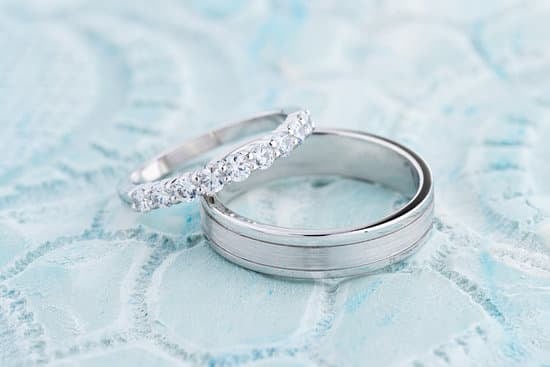The wedding band is a significant symbol of love and commitment, and the hand on which it is worn holds cultural, historical, and personal significance. Understanding why it matters which hand the wedding band goes on is essential for couples as they embark on this timeless tradition.
Throughout different cultures around the world, the choice of hand for the wedding band can vary widely. From the left hand in Western traditions to the right hand in Eastern customs, each culture has unique beliefs and customs surrounding the placement of the wedding band. This diversity highlights the importance of understanding cultural differences when it comes to this tradition.
Delving into the historical background of the wedding band reveals how its placement has evolved over time. From ancient Egypt to medieval Europe, the symbolism and meaning associated with wearing a wedding band have shifted, leading to different preferences regarding which hand it should adorn. Understanding this evolution sheds light on why choosing a specific hand for the wedding band continues to hold importance today.
As couples navigate their way through modern trends and practical considerations related to their wedding bands, understanding which hand to wear them on becomes crucial. In a world where symbolism, tradition, and personal preferences intersect, determining what hand for a wedding band has become more than just a question of aesthetics – it is a reflection of cultural heritage and personal significance.
Cultural Differences
In different cultures, the significance and symbolism of the wedding band can vary greatly, influencing which hand it is worn on. Understanding these cultural differences can provide insight into the diverse customs and traditions surrounding the wedding band.
Western Culture
In Western cultures, such as the United States and much of Europe, it is customary to wear the wedding band on the left hand. This tradition dates back to ancient Roman times when it was believed that a vein ran directly from the fourth finger on the left hand to the heart, known as the “vena amoris” or vein of love. This romantic notion has persisted through the centuries and remains a popular practice in Western weddings.
Eastern Culture
On the other hand (pun intended), in many Eastern cultures, including India and Russia, wearing the wedding band on the right hand is common. In some Middle Eastern countries, it is also traditional for men to wear their wedding bands on their right hands. These variations stem from cultural beliefs and historical customs that have been passed down through generations.
Other Cultural Practices
Additionally, there are numerous other cultural practices related to wearing wedding bands that differ from region to region. For example, in some Scandinavian countries, both men and women wear engagement rings on their right hands during the engagement period and then switch them to their left hands after marriage. Exploring these unique traditions sheds light on how diverse societies view and value this important symbol of commitment.
Historical Background
The history of the wedding band dates back thousands of years, with evidence of its use found in ancient Egypt and Rome. In these ancient civilizations, the wedding band was worn on the fourth finger of the left hand, as it was believed that this finger contained a vein that led directly to the heart, symbolizing love and commitment.
This tradition has continued through the centuries, with many Western cultures following suit and placing the wedding band on the same finger of the same hand.
Historically, some cultures have had different traditions regarding which hand the wedding band should be worn on. For example, in Eastern European countries such as Russia and Greece, the wedding band is traditionally worn on the right hand. This tradition stems from religious beliefs and cultural customs specific to those regions.
In more recent history, particularly during the Renaissance period in Europe, there was a shift towards wearing wedding bands on either hand or even on a necklace as a symbol of love and commitment. Over time, this practice evolved again to place greater emphasis on wearing the ring on a specific hand and finger. The historical background of the wedding band demonstrates how this small piece of jewelry holds significant cultural and historical significance across various regions around the world.
- The ancient Egyptians are known to have exchanged rings made from woven reeds
- The Romans were known for their intricate gold bands worn as a symbol of ownership by their wives
- During medieval times in Europe, couples began exchanging rings as a symbol of fidelity
- Victorian England popularized rings set with birthstones for each family member
Modern Trends
When it comes to choosing which hand to wear the wedding band on, modern trends play a significant role in influencing this decision. While traditional customs and cultural differences have historically dictated the hand on which the wedding band should be worn, contemporary preferences have shifted towards personal choice and individual style. Here are some of the current trends and preferences regarding the placement of the wedding band:
- Personalization: Many individuals now opt for personalization when it comes to their wedding bands, including choosing the hand on which to wear it. This could be based on personal beliefs, comfort, or simply aesthetics. The trend of personalizing the placement of the wedding band reflects a departure from traditional norms and a focus on individuality.
- Gender Neutrality: In recent years, there has been a shift towards gender-neutral practices, including the placement of the wedding band. Rather than adhering strictly to historical customs that dictate which hand is appropriate for men and women, many couples today choose to wear their wedding bands on the same hand as a symbol of equality and unity in marriage.
- Fashion Influences: Another modern trend that impacts the choice of which hand to wear the wedding band on is fashion. With trends in jewelry and accessories constantly evolving, some individuals may base their decision on which hand looks best with their overall fashion aesthetic.
Symbolism
The symbolism of wearing a wedding band on a specific hand varies across different cultures and traditions. For many Western cultures, including the United States and the United Kingdom, the wedding band is traditionally worn on the fourth finger of the left hand.
This finger is commonly referred to as the “ring finger” and is believed to have a vein that leads directly to the heart, symbolizing love and commitment. However, in some Eastern European countries such as Russia and Greece, the wedding band is worn on the right hand.
In addition to cultural symbolism, wearing a wedding band on a specific hand can also have personal significance for couples. Some individuals may prefer to wear their wedding bands on different hands based on their dominant hand or personal beliefs. In some cases, couples may choose to wear matching wedding bands on the same hand as a symbol of unity and connection.
Ultimately, what hand for wedding band has different meanings for different people. While tradition and culture play a significant role in determining which hand to wear the wedding band on, personal symbolism also influences this decision. Regardless of which hand it is worn on, the wedding band serves as a powerful symbol of love, commitment, and partnership.
| Country | Traditional Hand for Wedding Band |
|---|---|
| United States | Fourth finger of left hand |
| Russia | Right hand |
| Greece | Right hand (some regions) |
Practical Considerations
When it comes to choosing which hand to wear your wedding band on, there are several practical considerations that can influence this decision. One of the primary factors to consider is your dominant hand. For individuals who are right-handed, wearing the ring on the left hand may be more comfortable and less likely to interfere with everyday tasks. Conversely, left-handed individuals may prefer to wear their wedding band on their right hand for similar reasons.
Another point to consider is any existing jewelry you wear on a daily basis. If you frequently wear other rings or bracelets on a specific hand, you may want to place your wedding band on the opposite hand in order to balance out your jewelry and prevent potential discomfort or irritation from multiple pieces rubbing against each other.
Additionally, lifestyle considerations such as work or hobbies should also be taken into account. For example, individuals with physically demanding jobs or active lifestyles may choose to wear their wedding band on the hand that is least exposed to potential damage or injury.
Overall, while tradition and symbolism play a significant role in determining which hand for a wedding band, there are also practical aspects that should not be overlooked when making this decision.
| Practical Considerations | Decision Influences |
|---|---|
| Dominant Hand | Right-handed vs. Left-handed individuals |
| Existing Jewelry | Balancing out jewelry and reducing discomfort |
| Lifestyle Considerations | Work and hobbies influencing hand choice |
Etiquette and Tradition
When it comes to wearing a wedding band, etiquette and tradition play a significant role in determining which hand it should be worn on. Different cultures and traditions have varying guidelines for this, and understanding these can be crucial when it comes to honoring customs and respecting the significance of the wedding band.
Cultural Variations
In many Western cultures, including the United States and the United Kingdom, the wedding band is traditionally worn on the left hand. This tradition dates back to ancient Roman times when it was believed that a vein in the left ring finger, referred to as the “vena amoris” or “vein of love,” was directly connected to the heart.
However, in other cultures such as India, Russia, and Germany, it is more common to wear the wedding band on the right hand.
Symbolic Meanings
The choice of which hand to wear the wedding band on can also carry symbolic meanings. For example, in some Eastern European countries like Poland and Bulgaria, wearing the wedding band on the right hand signifies independence and individuality. On the other hand (no pun intended), wearing it on the left hand may convey a sense of unity and commitment within Western traditions.
Following Etiquette
In modern times, there are no strict rules dictating which hand one should wear their wedding band on. However, if you wish to adhere to traditional etiquette or honor your cultural background, it is important to consider these factors when making this decision. Ultimately, whether you choose to wear your wedding band on your left or right hand should be a personal choice based on what holds meaning for you and your partner.
Conclusion
In conclusion, the question of which hand to wear a wedding band on is both culturally and personally significant. The traditions and customs of different cultures vary widely in this regard, with some preferring the left hand and others the right. The historical background of the wedding band also shows how this practice has evolved over time, further emphasizing its importance.
Moreover, modern trends and preferences also play a role in determining which hand individuals choose for their wedding bands. While some may prioritize symbolism and tradition, others may consider practicality or personal preference when deciding. Ultimately, the decision should be made based on what feels right for the individual and their partner.
In terms of etiquette and tradition, it is essential to be mindful of any cultural or religious guidelines that may influence the decision. However, at its core, wearing a wedding band symbolizes commitment and love, regardless of which hand it adorns.
It is a personal choice that holds significant meaning for each couple, no matter where or how it is worn. Ultimately, the answer to “what hand for the wedding band” is one that lies within each couple’s unique story and values.
Frequently Asked Questions
Do Wedding Bands Go on the Left or Right Hand?
Wedding bands traditionally go on the left hand in the United States and most Western countries. This custom is believed to have originated from the ancient Egyptians, who believed that the vein in the fourth finger of the left hand, now known as the ring finger, led directly to the heart.
Which Hand Is the Wedding Band for Men?
In most Western cultures, including the United States, men typically wear their wedding band on their left hand. However, there are some cultures and traditions where men may wear their wedding band on their right hand.
Why Do Europeans Wear Wedding Ring on Right Hand?
Europeans wear their wedding ring on the right hand due to historical and cultural differences. For example, in countries like Germany, Austria and Russia, it is common for both men and women to wear their wedding rings on their right hand. This tradition stems from historical customs and beliefs specific to each region or country in Europe.

I have been involved in marriages for over 20 years helping couples and singles understand more about them.





